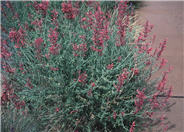
Common name:Licorice Hyssop
Botanical name:Agastache rupestris
Enjoyed for its fine, aromatic foliage and uniquely colored flowers, this is an excellent addition to a water-wise garden. Pale grey-green leaves are licorice scented and grow along stiff, upright stems, topped with orange and lavender flowers that bloom mid to late summer. Attractive to hummingbirds, butterflies, and bumblebees. Dead head for best flowering. It is native to mountain regions of Arizona, New Mexico and Northern Mexico.
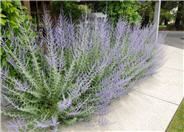
Common name:Russian Sage
Botanical name:Perovskia atriplicifolia
Russian sage may be the ubiquitous low-water garden plant. With its grey green, aromatic foliage, and azure blue spires, it provides a long-lasting show in hot, dry gardens. It grows to 3 to 5 feet tall, and nearly as wide. It is a woody perennial and forms a very hard trunk over time. It is both airy and substantial, and partners well with herbaceous perennials, woody shrubs, or ornamental grasses. It also would grow well against a south or west facing wall or fence.
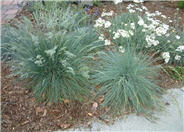
Common name:Blue Fescue
Botanical name:Festuca ovina glauca
This group of ornamental grasses generally grow less than a foot tall and have fine, green to blue-green, evergreen leaves that are very thin and hair-like. Flowers appear in the summer and have an airy and open appearance. Prefers full sun but will tolerate afternoon shade if not over-watered. It needs well draining soil and is drought tolerant once it's established. An evergreen, it may need tidying up in the spring; trim out dead foliage and seed heads.
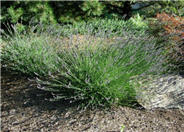
Common name:English Lavender
Botanical name:Lavandula angustifolia
English lavender is a dependably hardy, heat tolerant, drought resistant perennial, well suited to our arid, cold climate. Aromatic, green to grey-green foliage has a rich, resin scent, and grows in tight clumps 1 to 2 feet in height and width, depending on variety. Flowers form at the ends of stiff stems, in whorls of blue to lavender to purple, again, depending on variety. Flowers may add another 6 to 12 inches of height. Use in any sunny spot, such as perennial border, herb garden, parkstrip, lining a pathway.
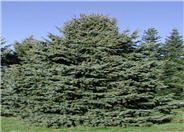
Common name:Colorado Spruce
Botanical name:Picea pungens
Colorado Spruce is an upright to pyramidal evergreen tree with a dense form and horizontal branches. It grows slowly, 60 to 80 feet tall and 20 to 30 feet wide. Its color is variable, ranging from sky blue to green. s to 100' tall. It has a wide-spreading, moderately deep root system if not overwaterred. A Utah native.

Common name:Karl Foerster Feather Reed Grass
Botanical name:Calamagrostis acutiflora 'Karl Foerster'
Karl Foerster feather reed grass is a garden favorite, and for good reason. Its green, fine-textured foliage is gently arching and grows to about 2 feet tall and wide. Oat-like plumes stand very erect over the foliage, growing as tall as 5 to 6 feet. Plumes open whiteish green, later turning a dusky rose, and then tawny colored by winter. Blooms early summer with the plumes lasting into autumn. Holds its presence well into winter. Excellent in mixed perennial or shrub borders, or massed.
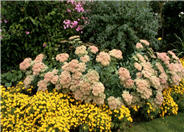
Common name:Autumn Joy Sedum
Botanical name:Sedum 'Autumn Joy'
Autumn Joy sedum is a garden staple, and for good reason. Emerging in early spring, fleshy, green to grey-green leaves form a rosette of foliage, and soon expands on sturdy stems, growing about 18 to 24 inches tall and wide. Flower heads begin to form in early to mid summer, looking something like little cauliflower, but soon the buds open to pale pink stars that progressively deepen in color, until they become a russet red in the fall. Use in perennial, shrub, or foundation borders, in parkstrips, with ornamental grasses. Attracts butterflies and bees. Flower heads persist well into winter.

Common name:Autumn Joy Sedum
Botanical name:Sedum 'Autumn Joy'
Autumn Joy sedum is a garden staple, and for good reason. Emerging in early spring, fleshy, green to grey-green leaves form a rosette of foliage, and soon expands on sturdy stems, growing about 18 to 24 inches tall and wide. Flower heads begin to form in early to mid summer, looking something like little cauliflower, but soon the buds open to pale pink stars that progressively deepen in color, until they become a russet red in the fall. Use in perennial, shrub, or foundation borders, in parkstrips, with ornamental grasses. Attracts butterflies and bees. Flower heads persist well into winter.
| Designer: Stephanie Duer | Flagstone Walk Garden 10 |
Photographer: GardenSoft |
Water Saving Tip:
Apply as little fertilizer as possible.
If you use fertilizer make sure it stays on the landscape, and carefully water it in so there is NO runoff.
